 The Reserve Bank of India’s (RBI) Monetary Policy Committee (MPC) met on February 6-8, 2023 , and released the Monetary Policy Statement, 2022-23 Resolution of the MPC which projected India’s real Gross Domestic Product (GDP) growth to 6.4% for FY24 (lower than 7% in FY23) with FY24’s Q1 at 7.8%, Q2 at 6.2%, Q3 at 6%, and Q4 at 5.8%.
The Reserve Bank of India’s (RBI) Monetary Policy Committee (MPC) met on February 6-8, 2023 , and released the Monetary Policy Statement, 2022-23 Resolution of the MPC which projected India’s real Gross Domestic Product (GDP) growth to 6.4% for FY24 (lower than 7% in FY23) with FY24’s Q1 at 7.8%, Q2 at 6.2%, Q3 at 6%, and Q4 at 5.8%.
- The stance is to focus on withdrawal of accommodation.
Inflation:
i.Consumer Price Index (CPI) inflation or retail inflation is projected at 5.3% for FY24, with FY24’s Q1 at 5%, Q2 at 5.4%, Q3 at 5.4%, and Q4 at 5.6%.
- This forecast is on the assumption of normal monsoon.
ii.Inflation is projected at 6.5% in FY23, with Q4FY23 at 5.7%.
- This is on the assumption of average crude oil price (Indian basket) at US$ 95 per barrel, and all other compatible factors.
iii.RBI set an objective of achieving the medium-term target for CPI inflation of 4% within a band of +/- 2%, while supporting growth.
iv.CPI headline inflation moderated to 5.7 per cent (y-o-y) in December 2022 – after easing to 5.9 per cent in November
v.Core CPI (i.e., CPI excluding food and fuel) inflation rose to 6.1 per cent in December due to sustained price pressures in health, education and personal care and effects.
RBI’s Policy Rates:
The MPC raised the repo rate by 25 basis points to 6.50% from 6.25%. Consequently, the Standing Deposit Facility (SDF) Rate was adjusted to 6.25% and Marginal Standing Facility (MSF) rate and Bank Rate to 6.75%.
| Category | Rate |
|---|---|
| Policy Repo Rate | 6.50% |
| Reverse Repo Rate | 3.35% |
| Standing Deposit Facility (SDF) Rate | 6.25% |
| Marginal Standing Facility (MSF) Rate | 6.75% |
| Bank Rate | 6.75% |
| Cash Reserve Ratio (CRR) | 4.50% |
| Statutory Liquidity Ratio (SLR) | 18% |
Domestic Economy:
i.As per the First Advance Estimates (FAE) released by the National Statistical Office (NSO) on January 6, 2023, India’s GDP growth at 7% year-on-year (y-o-y) in FY23 was driven by private consumption and investment.
ii.The Gross Value Added (GVA) was estimated at 6.7% in FY23.
iii.The economic activity has remained strong in Q3 and Q4FY23.
iv.The overall liquidity remains in surplus, with average daily absorption under the Liquidity Adjustment Facility (LAF) increasing to Rs 1.6 lakh crore during December 2022-January 2023 from an average of Rs 1.4 lakh crore in October-November, 2022.
v.As on January 27, 2023, on a y-o-y basis, money supply (M3) expanded by 9.8%, and non-food bank credit rose by 16.7%.
vi.As on January 27, 2023, India’s foreign exchange reserves are at US$ 576.8 billion.
vii.Net Foreign Direct Investment (FDI) flows remain strong at US $ 22.3 billion during April-December 2022 as compared to US$ 24.8 billion in April-December 2021.
viii.Foreign portfolio flows have shown signs of improvement with flows of US$ 8.5 billion during July 2022 to February 6, 2023.
ix.Net inflows under non-resident deposits increased to US$ 3.6 billion during April-November 2022 from US $2.6 billion in April-November 2021.
x.Industrial production is expanded by 7.1% in November 2022, after contracting by 4.2% in October 2022.
xi.Purchasing Managers’ Indices (PMIs) for manufacturing and services remained in expansion at 55.4 and 57.2 respectively in January 2023.
xii.Non-oil non-gold imports expanded in December 2022. However, merchandise exports contracted in December amid weak global demand.
xiii.Area coverage under rabi crops: Rabi acreage exceeded 2022’s area by 3.3 % as on February 3, 2023.
Global Economy:
i.Global growth is expected to decelerate during 2023.
ii.Weak external demand in major advanced economies (AEs), the rising incidence of protectionist policies, volatile capital flows and debt distress may impact adversely on prospects for emerging market economies (EMEs).
Additional Measures
UPI facility to inbound Travellers for Merchant Payments at airports
RBI proposed to permit all inbound travellers to India to use Unified Payments Interface (UPI) for their merchant payments (P2M) while they are in India. Initially it will be extended to travellers from G-20 countries arriving at select international airports.
RBI permits lending, borrowing of G-secs
RBI permitted lending and borrowing against Government Securities (G-secs) to increase the depth of the bond market. It also restored the market trading hours in G-Sec to pre-pandemic levels i.e. 9 am to 5 pm, from current timings of 9 am to 3:30 pm w.e.f. February 13, 2023 to normalize liquidity and market operations.
- This measure will also add depth and liquidity to the G-sec market; aid efficient price discovery; and work towards a smooth completion of the market borrowing programme of the centre and states
Accordingly, the revised trading hours for markets regulated by the RBI are as follows:
| Market | Timings with effect from February 13, 2023 |
|---|---|
| Call/notice/term money | 9:00 AM to 5:00 PM |
| Market repo in government securities | 9:00 AM to 2:30 PM |
| Tri-party repo in government securities | 9:00 AM to 3:00 PM |
| Commercial paper and Certificates of Deposit | 9:00 AM to 5:00 PM |
| Repo in Corporate Bonds | 9:00 AM to 5:00 PM |
| Government Securities (Central Government Securities, State Development Loans and Treasury Bills) | 9:00 AM to 5:00 PM |
| Foreign Currency (FCY)/Indian Rupee (INR) Trades including Forex Derivatives* | 9:00 AM to 3:30 PM |
| Rupee Interest Rate Derivatives* | 9:00 AM to 5:00 PM |
| *: other than those traded on recognised stock exchanges | |
What is a G-Sec?
It is a tradeable instrument issued by the Central Government or the State Governments and acknowledges the Government’s debt obligation. Such securities are short term (usually called treasury bills, with original maturities of less than one year) or long term (usually called Government bonds or dated securities with original maturity of one year or more).
- G-Sec carry practically no risk of default and, hence, are called risk-free gilt-edged instruments.
RBI to issue regulatory guidelines on Climate Risk and Sustainable Finance
In July 2022, RBI had issued a Discussion Paper on Climate Risk and Sustainable Finance. Based on the feedback received, RBI decided to issue guidelines for Regulated Entities (REs) on the following:
i. Broad framework for acceptance of Green Deposits
ii. Disclosure framework on Climate-related Financial Risks
iii. Guidance on Climate Scenario Analysis and Stress Testing.
These guidelines, to be issued in a phased manner, will be the first set of measures to address the impacts of climate change on the financial system.
RBI proposes to expand scope of TReDS to improve cash flows for MSMEs
RBI proposed to expand the scope of Trade Receivables Discounting System (TReDS) by the following:
i. Providing insurance facility for invoice financing
ii. Permitting all entities/institutions undertaking factoring business to participate as financiers in TReDS
iii. Permitting re-discounting of invoices (that is, developing a secondary market in TReDS).
Key Points:
i.These measures are expected to improve the cash flows of the MSMEs (Micro, Small & Medium Enterprises).
ii.For the benefit of MSMEs, RBI introduced a framework in 2014 to facilitate financing of their trade receivables through TReDS.
- The entities that are started operating TReDS platforms process about Rs 60,000 crore worth of transactions annually.
What is TReDS?
TReDS is an electronic platform for facilitating the financing/discounting of trade receivables of MSMEs through multiple financiers. These receivables can be due from corporates and other buyers, including Government Departments and Public Sector Undertakings (PSUs).
RBI to launch Pilot Project for QR-code based Coin Vending Machines
RBI will launch a pilot project on QR Code based Coin Vending Machine (QCVM) in 12 cities. These vending machines will dispense coins against debit to the customer’s account using UPI instead of physical tendering of banknotes.
- This will enhance the ease of accessibility to coins.
- Based on the learnings from the pilot, guidelines will be issued to banks to promote distribution of coins using these machines.
- The pilot project is planned to be initially rolled out at 19 locations in 12 cities across the country.
- These vending machines are intended to be installed at public places such as railway stations, shopping malls, and marketplaces to enhance ease and accessibility.
RBI renews authorization for white label ATMs to Vakrangee
RBI has extended the validity of authorization issued to Vakrangee Limited to setup, own and operate White Label ATMs (Automated Teller Machines) in India till March 31, 2024.
Key Points:
i.The company currently operates 6,283 White Label ATMs and 77 per cent of these are in Tier 4 and 6 locations
ii.White Label ATMs are ATMs set up, owned and operated by non-banks.
- Non-bank ATM operators are authorised under the Payment & Settlement Systems Act, 2007 by the RBI.
The next meeting of the MPC is scheduled during April 3, 5 and 6, 2023.
Recovery of Penal Charges on Loans
i.As per the RBI’s review, most banks use penal rate on top of the normal interest rates in case of payments defaults and non-compliance with the terms and conditions of sanctioning the credit facilities.
ii.Following customer grievances regarding the imposition of penalties on delayed loan payments, the RBI intends to issue draft guidelines on the recovery of penal charges on loans.
iii.According to the revised guidelines, the penalty for delay/default in servicing loans or loan contracts will be in the form of ‘penal charges’ in a reasonable and transparent manner, instead of being levied as ‘penal interest’ that is added to the rate of interest being charged on the advances.
Members of MPC:
Dr. Shashanka Bhide; Dr. Ashima Goyal; Prof. Jayanth R. Varma; Dr. Rajiv Ranjan; Dr. Michael Debabrata Patra; and headed by Shaktikanta Das (RBI Governor).
About Reserve Bank of India (RBI):
i.The Reserve Bank of India was established on April 1, 1935, in accordance with the provisions of the Reserve Bank of India Act, 1934.
ii.The Central Office of the Reserve Bank was initially established in Calcutta but was permanently moved to Mumbai in 1937.
iii.Though originally privately owned, since nationalization in 1949, the Reserve Bank is fully owned by the Government of India.
iv.Thus, 2023 marks the 75th year of public ownership of the Reserve Bank and its emergence as a national institution.




